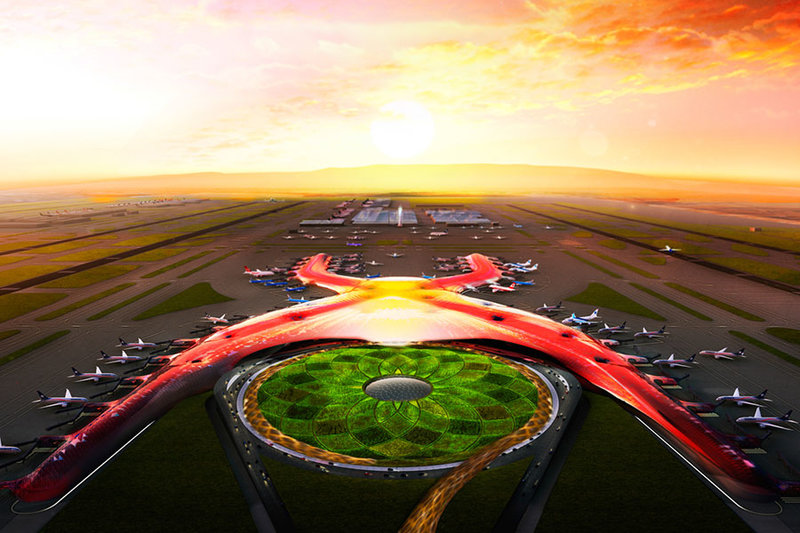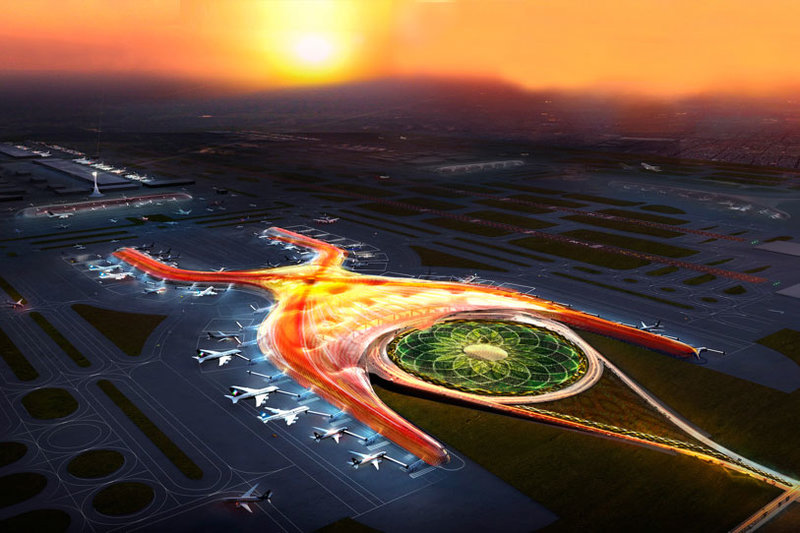PROJECTS
Mexico: ambitious airport plans hang on a knife edge
The
future
of US air
traffic control:
the third option?
Currently under construction, Mexico City’s New International Airport is the country’s most expensive endeavour in a century. But with the country’s new President threatening to call time on the project, what could Mexico stand to lose? Joe Baker finds out
I
n the centre of a dried up lakebed in the heart of Mexico, one of the world’s biggest airport construction projects edges closer to fruition. At an estimated cost of $13bn, Mexico City’s New International Airport (NAICM) is the largest infrastructure project the country has taken on for over a century, and is set to be one of the biggest airports in the Western Hemisphere when it opens in 2020. However, whether it will get to that stage is still anyone’s guess.
Unveiled by President Enrique Peña Nieto in 2014, NAICM is a solution to Mexico’s burgeoning aviation demand, which has left the capital’s existing airport struggling to cope. With just two runways, Benito Juarez International is currently the busiest airport in Latin America. An excess of 44 million passengers passed through its doors, designed for just 32 million, in 2017.
Currently being constructed by Grupo Aeroportuario de la Ciudad de México (GACM), NAICM’s 8 million square foot terminal and three runways will yield a capacity for 68 million passengers annually when it opens in 2020. Three further phases of development are set to follow, with the final phase delivering a total of six runways, an additional terminal, and capacity for 125 million passengers by 2065.
However, new developments in Mexico have potentially left the fate of the project hanging in the balance. In July, left-wing politician Andrés Manuel López Obrador (commonly known as AMLO) was elected as Mexico’s new President, primarily due to his pledge to root out corruption in the country. For him, no better example of dodgy dealings exists than the NAICM, which has steadily ballooned in cost from $9bn to $13bn since its inception, and has been plagued by delays and environmental outcry from the outset.
Speculation has been rife over the potential axing of NAICM, and what implications this might have for Mexico’s aviation industry, interconnectivity and overall economy. But what exactly could the nation be losing in the course of this project?
Image courtesy of Presidencia de la Republica Mexicana via Flickr
Grand designs
NAICM’s gargantuan size is eye-catching in itself, but futuristic concept art provided by its creators points to a design that looks decades ahead of its time. Pritzker-winning architect Norman Foster of Foster + Partners worked on the terminal design alongside Fernando Romero, a renowned designer (and son-in-law of key NAICM investor Carlos Slim).
According to Foster, NAICM’s 1.6km long, X-shaped terminal will reflect Mexico’s symbolism and history. A massive cacti garden situated at the terminal’s entrance links with the image of cacti embroidered on the country’s national coat of arms, while access roads and the terminal’s curved roof represent the shield’s snakes and eagle, respectively.

Image courtesy of Presidencia de la Republica Mexicana via Flickr
Taking the form of a continuous curved grid-shell, the terminal ebbs and flows into large atriums with vast potential for retail opportunities, while the lightweight roof is supported by 21 funnel-shaped structures that merge tarpaulin-like into the ceiling. There’s space for 96 departure gates, a number expected to meet capacity requirements at the airport until 2028.
The airport’s designers claim it will be the ‘most sustainable’ on Earth, and qualify for the LEED’s first platinum rating. Pipes and ducts will service the terminal from below, allowing its roof to fulfil a number of purposes such as harnessing solar power and collecting rainwater. Displacement ventilation technology will also allow terminals to be filled with almost 100% outside air, removing the need for additional heating or cooling.
Eero Knuutila is Head of Service Development at Helsinki Airport.
Image courtesy: Helsinki Airport
The airport’s designers claim it will be the ‘most sustainable’ on Earth, and qualify for the LEED’s first platinum rating
Challenges and setbacks
Despite the ambition on display, there have been several challenges and setbacks involved with the project. Construction has moved more slowly than expected due to nature of its local terrain, the marshy wetland of Texcoco. Mexico City’s drainage of water from underground aquifers is steadily causing the ground of the airport’s construction site to dip by between eight and 16 inches every year. Storm-water during the country’s rainy season also flows naturally into the wetlands, creating a greater risk of flooding.
“In terms of feasibility, it’s just the worst terrain,” Fernando Córdova Tapia, environmental impact specialist at the National Autonomous University of Mexico, told Alto Nivel. “There’s a reason why this part of the city hasn’t ever been urbanised.”

Image courtesy of Presidencia de la Republica Mexicana via Flickr
GACM’s solution to the sinking problem has been to pave NAICM’s 12,400-acre construction space with volcanic rock that will sink into the ground, squeezing water out of the earth and making the runways hardy enough to withstand landing planes. A drainage system of tunnels, canals and pipes is also being built to get rid of excess water.
Despite the airport’s commitment to LEED platinum certification, the potential still exists for a massive environmental impact elsewhere. In particular, the construction of the facility will affect the habitats of more than 130 bird species living on the wetlands of Texcoco, and worsen Mexico City’s ongoing water shortage crisis.
Construction has moved more slowly than expected due to nature of its local terrain, the marshy wetland of Texcoco
The rocky road ahead
Aside from these setbacks, soon-to-be president AMLO has had two main issues with the project in the past, saying in March that it’s too expensive and accusing authorities of giving out contracts in return for political favours. Instead, he has suggested keeping Benito Juarez operational while transforming an Air Force base north of Mexico City into another small airport to increase capacity while keeping costs down.
This idea was criticised in a CityLab article by Gregorio García Morales, president of the Mexican College of Aeronautical Engineers, who said that flights from Santa Lucia and Benito Juarez would intersect and cause significant risk to pilots.
The assertion of corruption has been flagrantly denied by GACM, which has been working with the Organisation for Economic Cooperation and Development to structure a more transparent bidding process, and also create a protection guide that will allow employees to whistleblow on acts of corruption.

Image courtesy of Presidencia de la Republica Mexicana via Flickr
In addition, the potential financial impact of a full-scale cancellation of the project has been well documented. GACM chief executive Federico Patino said in March that with the project coming close to the halfway point by the end of 2018, the cumulative severance costs, lawsuits and damages would amount to around $6.6bn. In April, the International Air Transport Association (IATA) released a report saying that scrapping the airport would mean Mexico could attract 20 million fewer passengers per year by 2035, and subsequently miss out on $20bn in future GDP contributions and up to 200,000 Mexican jobs.
“A new airport is vital to enable Mexico City to benefit more fully from its ideal geographic position linking North America and Latin America,” said Peter Cerda, IATA’s regional vice president for the Americas.
It’s likely that these factors have led AMLO to soften his stance, calling for a suspension and possible thorough review of the project involving private sector and government experts rather than an all-out ban. In May, he also said that he “wouldn’t have a problem” with the airport project being put out to the private sector in a concession – a prospect that could keep businesses on side.
Whether AMLO will follow through on his threat to stall the project, or otherwise fulfil his political promise in a traditional manner (i.e., not at all), it’s clear that environmental issues and costs could have their own negative impact on the project’s timescale. As a result, the future remains unclear for a project that could raise the profile of Mexican aviation in years to come.
Eero Knuutila is Head of Service Development at Helsinki Airport.
Image courtesy: Helsinki Airport
Scrapping the airport would mean Mexico could attract 20 million fewer passengers per year by 2035